Australian Grayling
Australian GraylingPrototroctes maraena | |
|---|---|
| Kingdom: | Animalia |
| Phylum: | Chordata |
| Class: | Actinopterygii |
| Order: | Osmeriformes (formerly Salmoniformes) |
| Family: | Retropinnidae (formerly Prototroctidae) |
| Sub-family: | Prototroctinae |
| Status | |
| World: | vulnerable IUCN 2025 |
| Australia: | vulnerable EPBC Act listed |
| Victoria: | endangered (FFG threatened list 2024) |
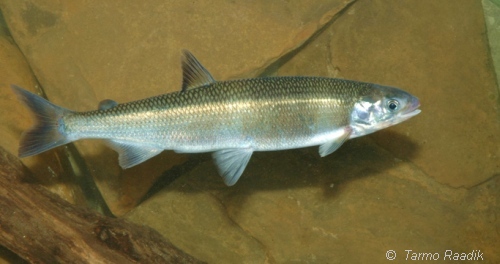
The Australian Grayling (Prototroctes maraena) also known as the Cucumber Fish or Cucumber Herring due to a cucumber odour when freshly caught is a small to medium sized freshwater fish only found in south-eastern Australia.
The Australian Grayling attains a maximum length of about 30cm but usually about 17-19cm. It is a soft rayed fish with the dorsal fin located behind the pelvic fin. Its coloration can be variable from dark brown to olive-green with greenish bronze sides occasionally with a steel blue sheen, silvery gill cover, silvery white to yellowish on the lower part of the head and body, fins are clear to grayish or straw coloured (Lake 1971; McDowall 1976; Cadwallader & Backhouse 1983; McDowall 1996).
Distribution
The Australian Grayling is distributed amongst the coastal streams flowing east and south of the Great Dividing Range from near Sydney in New South Wales around to the Hopkins River in south-west Victoria. It is also found on Tasmania and King Island (Lake 1971; McDowall 1976). There have been isolated records extending into south-eastern South Australia in the past but it is now considered extinct in this area (Hammer 2001).
Victorian records are most prolific in the Tambo, Barwon, Mitchell and Tarwin river systems (Jackson & Koehn 1988). In south-west Victoria important streams are; Barwon River, Erskine River, St Georges River, Cumberland River, Wye River, Carisbrook Creek, Skenes Creek, Wild Dog Creek, Barham River, Calder River, Aire River, Gellibrand River, Curdies River and Hopkins River. In 2020 and 2021 new records were confirmed in the Glenelg River which is significant in that previous records date back to 1899. Another significant development is recording of new recruits in the Yarra River in 2022.
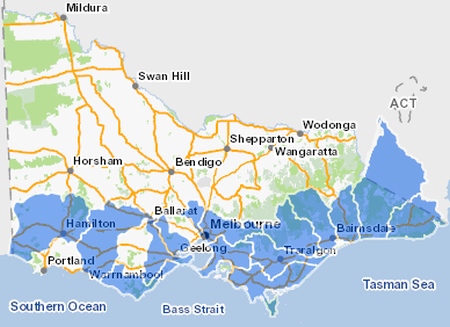
Distribution of Australian Grayling in Victoria from all known records. Source: VBA, Department of Environment, Land, Water and Planning 2022.
Ecology & Habitat
The Australian Grayling is predominately a freshwater fish but is considered diadromous because the fry have a marine phase (Crook et. al. 2006). The majority of its life however is spent in freshwater, inhabiting rivers and streams, usually in cool (5-26°C), clear waters with a gravel substrate and alternating pool and riffle zones (Bishop & Bell 1978; Berra 1982) but it has also been recorded to occur in turbid water with muddy-bottomed, heavily silted habitat as well (Jackson & Koehn 1988). Grayling can penetrate well inland, and have been reported over 100 km upstream from the sea (Jackson & Koehn 1988), provided there are no barriers to movement.
Spawning
The onset of spawning conditions tends to vary between February to May depending on the river systems across its range. Studies have found a drop in water temperature and an increase in flow are factors which trigger spawning conditions. A study at the Bunyip River in Victoria has demonstrated the existence of a downstream spawning migration and the importance of increased river flow as a migration cue for Australian Grayling (Koster et al. 2013). Studies in the Barwon River (Hall and Harrington 1989) recorded spawning from late May into early June and found a drop in salinity is also a factor in spawning success as eggs are not tolerant of salinity greater than 5 ppt.
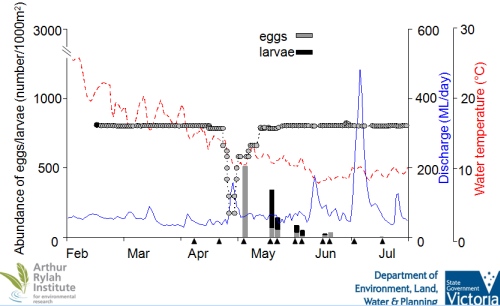
Depositing eggs
Studies into the lifecycle of the Australian Grayling, found that mature females caught from late March to early May had an average of 47,000 non-adhesive demersal eggs of 0.9 mm mean diameter (Berra 1982). Once released, the eggs settle in the crevices of the gravel bottom. The eggs hatch after 10-20 days and upon hatching the slender, buoyant larvae are about 6.5 mm long and swim actively to the water surface where they are swept downstream to brackish water in an estuary.
Larvae movement to the sea
Larvae probably move into the sea rather than remain in estuaries (Schmidt et.al. 2010, Crook et al. 2006) where they remain for about six months before migrating into streams. Juveniles ascend to the mid-reaches of the river where they spend the rest of their lives. (Berra 1982, Schmidt et al. 2011).
Juvenile migration to freswater
Research into the migration patterns of juvenile grayling into the freshwater environment was studied in four streams in south-east Australia across 3 years (2016–18) by (Koster et. al 2020). The studies found juvenile migration occurred from September to December, with peak abundances between late October and early November with the highest movement at intermediate flows (~100–150 ML day–1).
Life expectancy is thought to be about six years.
Feeding
Australian Grayling are omnivorous feeding on aquatic insect larvae, small amounts of plant material, including macrophytes and filamentous algae (Jackson, 1976; Cadwallader & Backhouse 1983; Berra et.al. 1987).
Population Status
Considered Endangered, the Australian Grayling has declined in abundance, reflecting of the poor state of its habitat which has suffered since European settlement.
The New Zealand Grayling Prototroctes oxyrhynchus is a close relative the of the Australian Grayling but now considered extinct.
Threats
Construction of barriers
Artificial barriers which restrict movement of the Australian Grayling include in-stream dams, weirs, and culverts or anything that impedes the upstream migration of juveniles or the downstream migration of fry. Failure to complete these migratory phases can cause local extinction in the section of river upstream from the barrier or impact on the overall viability of the population in a river.
Migrating juveniles congregate below barriers when their upstream passage is blocked and are much more vulnerable to predation by larger fish and birds, and capture by humans. It should be noted that there has been a considerable undertaking in recent years to minimise the impacts from artificial barriers in the south-west under the Fishways program which has reinstated fish passage to streams containing Grayling. This has been achieved via the Corangamite Catchment Management Authority.
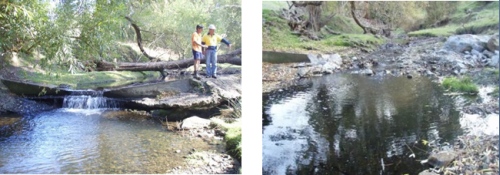
Low flows
The Australian Grayling depends on flooding events to spawn. Sites which are highly regulated and do not receive flooding flows (particularly during spring) may not provide conditions which are required to initiate spawning and the associated flows necessary to carry larvae to sea. Additionally, lack of flows through water abstraction may lead to a reduction in the period in which the rivers estuarine entrance is open to the sea. This may lead to the inability of larval grayling to access habitat necessary for their early development.
Flows in several of the priority streams (e.g. Barwon River, St George River, Barham River, Gellibrand River, Yarra River, Thomson River and Tarwin River) are subject to demands for water supply purposes which mean at times natural flows are reduced. When the seasonality and height of flooding is reduced through retention in dams, weirs and off-takes this can reduce the reproductive potential of the adults. If flooding doesn’t occur, females fail to spawn (O’Connor & Mahoney 2004). Missing a spawning season has major consequences for this species because it may spawn only once or twice in its entire life.
Drought conditions limit the high flow events required for spawning but also impact on base flows, particularly during summer when water quality can deteriorate resulting in low dissolved oxygen levels and higher than normal water temperatures. Australian Grayling require Dissolved Oxygen levels above 7 ppt and need to be able to access areas of stream with suitable levels of dissolved oxygen particularly in periods of low flows and high water temperatures.
With the onset of climate change, forecasts predicting reduced rainfall and more extreme temperatures are likely to result in a further deterioration of stream flow and in-stream conditions which places additional pressure on populations of Australian Grayling.
Sedimentation, nutrients & salinity
The condition of the catchment and activities being undertaken in the catchment has an impact on water quality. Sedimentation from erosion, washed out vehicle tracks, streamside disturbance and clearing of vegetation can increase sediment loads which smother instream substrates damaging feeding and spawning habitat. Movement of sediments from land into water is often accompanied with an increased flow of nutrients. Nutrients can also leach into waterways from agricultural run-off which causes excessive algal growth further damaging habitat
The formation of saline pools from low flows is a recognised problem in the Barwon River. Saline discharge from drainage schemes has also been recognised as an issue for Grayling in the Barwon River particularly during the spawning season, because the egg stage is sensitive to salinity above 5 ppt. Mortalities of larvae have been recorded above 10 ppt (Bacher & O’Brien).
Impact of Introduced Fish
A number of introduced fish species, occur within the distribution of Australian Grayling with Brown TroutSalmo trutta, considered to be a competitor/predator species. Brown Trout are known to prey on small grayling and are also likely to compete for habitat as grayling and trout occur in similar habitats (Jackson & Koehn 1988). Although streams containing grayling in south-west Victoria have not been stocked with Brown Trout for over 20 years self supporting populations of Brown Trout exist in most of the Otway streams. Larvae and juveniles may be highly susceptible to predation during their migration from marine waters through estuaries and then upstream to the adult habitats, where they pass through areas occupied by Brown Trout. Barriers and areas of low flow may also exacerbate susceptibility to predation.
Loss of instream habitat
Instream habitat provides shelter and food and is a vital part of the stream ecology. Removal of wood debris and snags has a detrimental impact on grayling. Removal of streamside vegetation also impacts on instream ecology through reduced shelter, food and increased water temperatures and siltation.
Fishing
Recreational angling is generally a low level impact but has the potential to be an issue when Australian Grayling aggregations occur below in-stream barriers and can be caught in large numbers.
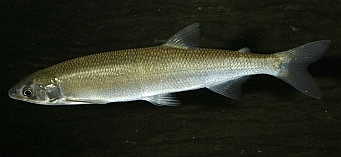
Conservation & Management
At known priority sites Australian Grayling populations are monitored every three years to confirm status including (a) identification of the area and extent of populations; (b) estimates of the size and structure of populations; (c) inference or estimation of population change and (d) habitat quality. This work is carried out by CMA's in conjunction with DELWP, Arthur Rylah Institute.
Additional activities:
- Implement seasonal environmental water flows at selected rivers
- Promote angler awareness regarding conservation of Australian Grayling
- Acquire baseline data on selected populations by conducting surveys
- Undertake surveys to determine additional populations
- Restore riparian habitat, conducted primarily through Catchment Management Authorities.
Priority streams in Victoria
Systems that have a natural flow regime (no major impoundments or regulation) are noted to be extremely important sites for this species, as a natural flow regime is necessary to trigger certain vital biological functions (i.e. spawning) (Saddlier et al. 2009).
South Gippsland Shire - Primary river manager West Gippsland CMA
- Agnes River
- Franklin River
- Tarwin River - need for environmental flows and fishways
Colac Otway Shire - Primary river manager Corangamite CMA
- Aire River
- Barham River
- Calder River
Corangamite Shire - Primary river manager Corangamite CMA
- Gellibrand River - need for environmental Water Release (EWR) to accommodate triggering of spawning behaviour (spring months)
East Gippsland Shire - Primary river manager East Gippsland CMA
- Mitchell River - impacts from siltation and barriers.
- Snowy River
- Tambo River - issues with water quality, sedimentation and barriers.
Wellington Shire - primary river manager West Gippsland CMA
- Albert River
- Avon River
- Latrobe River
- Macalister River
- Thomson River (need for combating threats inc. barrieres, environmental flows and habitat restoration).
Surf Coast Shire - Primary river manager Corangamite CMA
- Barwon River (major threats from low flows and instream barriers) Identify and map important spawning habitat Construct appropriately designed fishway on Buckleys Falls - completed 2015).
Moyne Shire - Primary river manager Glenelg Hopkins CMA
- Curdies River
- Hopkins River (threats inc. habitat decline due to agricultural intensification and residential / commercial development).
Glenelg Shire - Primary river manager Glenelg Hopkins CMA
- Glenelg River (environmental flows result in grayling returning to the system)
Banyule City, Boroondara City, Manningham City, Nillumbik Shire, Yarra City and Yarra Ranges Shire - Primary river managers - Melbourne Water, Port Phillip and Westernport CMA.
- Yarra River - (issues with water quality, barriers and flow).
Surveys in the Barwon River
The Barwon River has documented spawning for Australian grayling and is considered to support a significant population of this species. This species was recorded from the Barwon River in 1919, 1930 and 1981. Surveys conducted since 1986 recorded numbers of grayling per survey which ranged from one to 30 individuals. Surveys conducted in 1987 recorded 4 and 17 Grayling, while in 1997, one to 14 individuals were recorded. The 1998 surveys recorded 1,1,3,4,5 and 8 individuals. Note that population abundance data for this species should be interpreted cautiously, due to inconsistencies with sampling and the patchy nature of populations.
Other actions
The Corangamite CMA has completed a plan titled - Significant fish species protection under dry inflow conditions project (pdf)
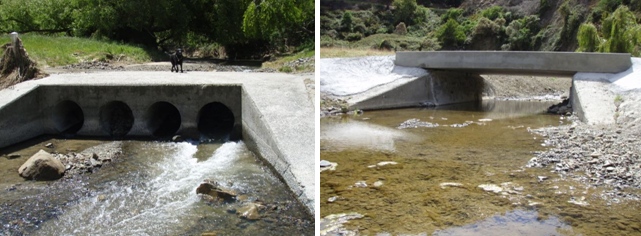
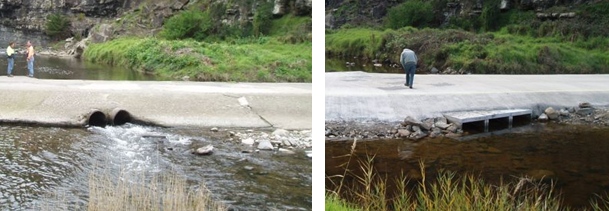
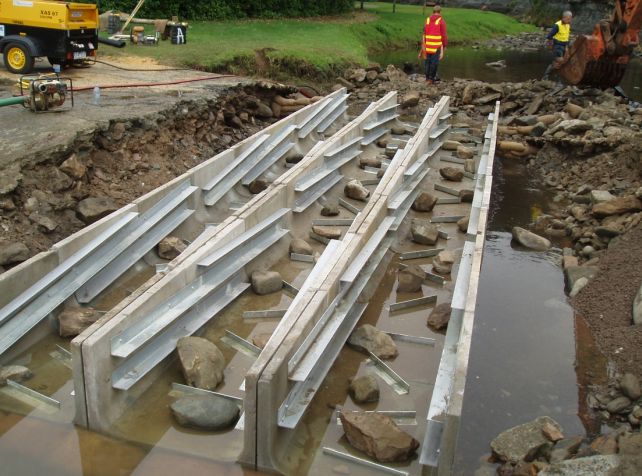
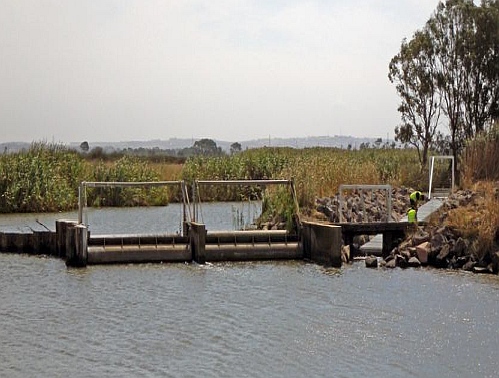
Installation of a vertical slot fishway on the Barwon River completed February 2013. Fishway entrance to the right of the main weir which separates freshwater river water from saline estuarine water. Two days after operation thousands of fish were observed using the fishway therefore being able to complete their natural migrations within the river system.
Images: Denis Loveric, Corangamite CMA
Projects & Partnerships
Environmental Flows Monitoring and Assessment Program (VEFMAP) in West Gippsland CMA
During the protracted seasons of drought in the previous decade, populations of Australian grayling were shown to decline in the system (Amtstaetter et al., 2013). Managed autumn fresh releases using environmental water entitlements have been made in consecutive years (2010-2015). As part of the DELWP funded Victorian Environmental Flows Monitoring and Assessment Program (VEFMAP), fish surveys have been undertaken in the Thomson, Macalister and Latrobe rivers and recent surveys have identified an increase in Australian grayling numbers within the Thomson River. VEFMAP monitoring in 2013 used acoustic tracking devices to track the downstream migration of Australian grayling during the autumn fresh and drift nets captured a large number of grayling eggs and larvae during this event. Similarly, monitoring in 2014 found increasing Australian grayling egg density corresponding to the release of an autumn fresh in the Thomson River. These results demonstrate that autumn freshes are very important for the regeneration of Australian grayling within this system.
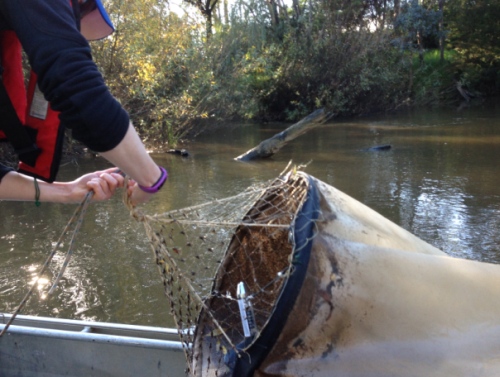
Environmental watering research
In order to assess the effects of environmental water flows on Australian Grayling movement and spawning the Arthur Rylah Institute conducted research between 2008 to 2015 in the Bunyip River, Yarra River, Thompson River and Tarwin River. Studies focused on determining flows necessary to stimulate movement and downstream spawning migrations from March to May.
Findings from the research confirmed that an increase in flow triggers downstream migration and spawning of Australian Grayling. Even modest flows of environmental water added to a low river flow for more than 5 days can result in movement and spawning.
More information: ARI Fact sheet 3 - Spawning success of Australian Grayling pdf
Environmental flows help grayling return to the Glenelg River
Environmental flows were introduced to the Glenelg River system in 2010 to help conserve and restore the river’s health and biodiversity. In 2019 an Australian Grayling was recorded in surveys in the Glenelg River which is the first record in over 120 years with the last record being 1899. In 2021, surveys found further evidence that grayling are once again returning to the Glenelg River. The return of grayling to the river is attributed to the combined benefits of environmental water and the removal of 13 fish barriers in the river system.
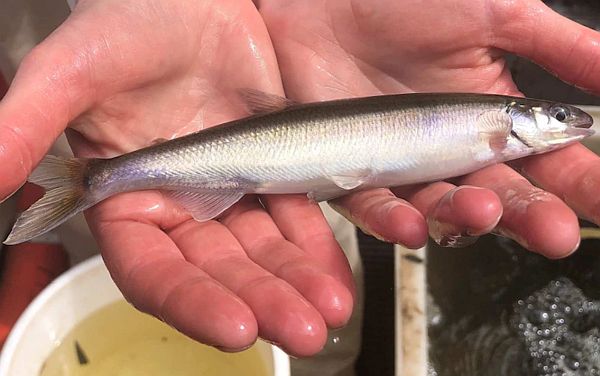
Environmental flows in West Gippsland CMA area
Environmental flows help grayling in the LaTrobe River
Environmental flows in 2015/16 are attributed to the first recorded spawning of Australian Grayling in the La Trobe River which occurred in 2015. Subsequent surveys were carried out in 2021 as part of the Victorian Environmental Flows Monitoring and Assessment Program (VEFMAP). From 2021 – 2023 natural rainfall increased river flows which exceeded the environmental flow requirements.
Other rivers with regular fish monitoring are the Thomson and Macalister Rivers, which are surveyed more frequently through VEFMAP and the Native Fish Report Card program. The 2022- 2023 surveys found there had been an increase in Australian Grayling in the Mccalister River whilst a decline of Australian Grayling occurred in the Thomson River, possibly due to competition or predation from other fish and introduced species such as Carp and Trout.
West Gippsland CMA Water for the environment snapshot 2023-24
The WGCMA has also embarked on a plan to improve management of salinity, water quality, instream and address an environmental flow deficit. Transformation of the Latrobe: Pathways for the Latrobe River System, Final Report, August 2022 – pdf
East Gippsland CMA area - Mitchell River
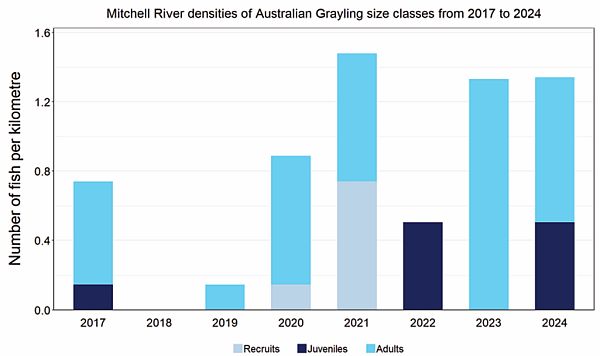
Surveys carried out as part of the Native Fish Report Card in the Mitchell River between 2017 – 2024 found the presence of Australian Grayling in all years except 2018. The 2024 surveys detected both adult and juvenile fish which indicates conditions were suitable for recruits to enter the river system in 2023. NFRC Mitchell River 2024
Surveys in the Yarra River
Low abundances were recorded between 2018 - 2024 with no records in 2017 and 2020. Recruits have been detected some years which is a good sign. The presence of recruits in 2022 and juveniles in 2018-19 and 2021-22 indicates stream conditions were suitable for recruits to be attracted into the system.
Surveys only detect low numbers of adult fish which could mean the river may not be able to support a flourishing population.
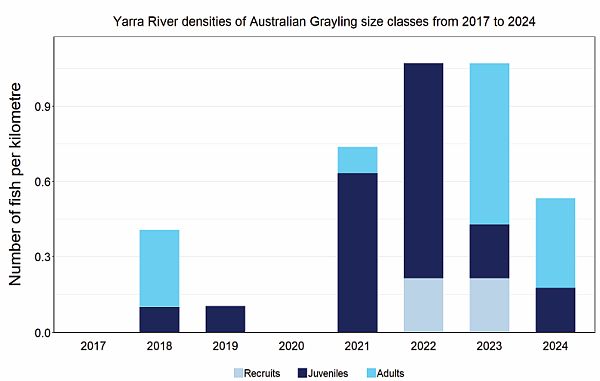
References & Links
- Amtstaetter, F., Dawson, D., O’Connor, J (2015) Improving our ability to collect eggs of the threatened Australian grayling, Prototroctes maraena Marine and Freshwater Research
- http://dx.doi.org/10.1071/MF14277 Submitted: 8 September 2014 Accepted: 31 January 2015 CSIRO Publishing Published online: 27 May 2015 - Bacher, G.l., O’Brien, T.A. (1998) Salinity tolerance of the eggs and larvae of the Australian grayling, Prototroctes maraena Gnnther (Salmoniformes : Prototroctidae), Australian Journal of Marine and Freshwater Research 40(2) 227 - 230 [1] Full text doi:10.1071/MF9890227
- Berra, T., (1982). Life history of the Australian grayling, Prototroctes maraena (Salmoniformes: Prototroctidae) in the Tambo River, Victoria. Copeia 1982: 795-805.
- Berra, T., Campbell, A., & Jackson, P., (1987). Diet of the Australian grayling, Prototroctes maraena Günther (Salmoniformes: Prototroctidae), with notes on the occurrence of a trematode parasite and black peritoneum. Australian Journal of Marine and Freshwater Research 38: 661-669.
- Bishop, K., & Bell, J., (1978). Observations on the fish fauna below Tallowa Dam (Shoalhaven River, New South Wales) during river flow stoppages. Australian Journal of Marine and Freshwater Research 29: 543-549.
- Cadwallader, P., & Backhouse, G., (1983). A Guide to the Freshwater Fish of Victoria. Government Printer, Melbourne.
- Crook, D.A., Macdonald, J.I., O'Connor, J.P., Barry, B. (2006) Use of otolith chemistry to examine patterns of diadromy in the threatened Australian grayling Prototroctes maraena, Journal of Fish Biology, Volume 69, Issue 5, November 2006, Pages: 1330-1344
- FFG Threatened List (2024) Flora and Fauna Guarantee Act Threatened List, Department of Energy, Environment and Climate Action (DEECA).
- Hall, D. N., and Harrington, D. J. (1989). Studies on the spawning and early life history of Australian grayling, Prototroctes maraena Günther, in the Barwon River, Victoria. Arthur Rylah Institute for Environmental Research Technical Report Series No. 84. Department of Conservation, Forests and Land, Melbourne.
- Hammer, M.,(2001) Freshwater Fishes of South Eastern South Australia (Data Sheet), Published by Native Fish Australia (SA) Inc.
- IUCN (2025) Koster, W. & Gilligan, D. 2019. Prototroctes maraena. The IUCN Red List of Threatened Species 2019: e.T18383A123378802. https://dx.doi.org/10.2305/IUCN.UK.2019-3.RLTS.T18383A123378802.en. Accessed on 11 March 2025.
- Jackson, P., (1976). A note on the food of the Australian grayling, Prototroctes maraena Günther (Galaxoidei: Prototroctidae). Australian Journal of Marine and Freshwater Research 27(3): 525-528.
- Jackson, P., & Koehn, J., (1988). A review of biological information, distribution and status of the Australian grayling (Prototroctes maraena) Günther in Victoria. Arthur Rylah Institute for Environmental Research Technical Report Series No. 52. Conservation Forests and Lands, Melbourne.
- Koster, W.M., Dawson, D.R., Crook, D.A. (2013) Downstream spawning migration by the amphidromous Australian grayling (Prototroctes maraena) in a coastal river in south-eastern Australia Marine and Freshwater Research 64(1) 31-41 http://dx.doi.org/10.1071/MF12196
- Koster, W.M., Amtstaetter, F., Dawson, D., Coleman, R.A., Hale, R. (2020) Environmental influences on the juvenile migration of the threatened amphidromous Australian grayling (Prototroctes maraena) Marine and Freshwater Research - https://doi.org/10.1071/MF20039 https://www.publish.csiro.au/mf/MF20039 July 2020.
- Lake, J., (1971). Freshwater Fishes and Rivers of Australia. Nelson, Melbourne.
- McDowall, R., (1976). Fishes of the Family Prototroctidae. Australian Journal of Marine and Freshwater Research 27(4): 641-659.
- McDowall, R., (1996). Family Prototroctidae Southern graylings. Pp 96–98 in McDowall, R.M. (ed.). Freshwater Fishes of South-eastern Australia. Reed Books, Chatswood.
- O’Connor, J., & Mahoney, J., (2004). Observations of ovarian involution in the Australian grayling (Prototroctes mareana). Ecology of Freshwater Fish 13: 70-73.
- Schmidt, D. J., Crook, D. A., O’Connor, J. P. and Hughes, J. M. (2011), Genetic analysis of threatened Australian grayling Prototroctes maraena suggests recruitment to coastal rivers from an unstructured marine larval source population. Journal of Fish Biology, 78: 98–111. doi: 10.1111/j.1095-8649.2010.02844.x
More Information
- National Recovery Plan for Australian Grayling 2008
- Australian Grayling DPI, New South Wales
- Australian Grayling Tasmania
- Victorian Environmental Water Holder – more information on environmental water flows in Victoria and latest releases.

